I’ll show you how to choose eco-friendly toilet paper in this step-by-step guide.
I’ll explain why it’s important to make this switch and the impact of traditional toilet paper on the environment.
We’ll explore the benefits of bamboo toilet paper and how to identify truly biodegradable options.
I’ll compare different eco-friendly toilet paper brands and help you find the right one for you.
Plus, I’ll share tips for properly disposing of biodegradable toilet paper.
Let’s make the switch together!
Why Choose Eco-Friendly Toilet Paper

I choose eco-friendly toilet paper because it helps protect the environment. Sustainability practices and environmental consciousness are important to me, and using eco-friendly toilet paper is a simple yet impactful way to contribute to a healthier planet.
Traditional toilet paper is often made from virgin trees, which contributes to deforestation and habitat destruction. In contrast, eco-friendly toilet paper is made from recycled materials or sustainably sourced bamboo. By choosing eco-friendly options, I’m supporting sustainable forestry practices and reducing my carbon footprint.
Additionally, eco-friendly toilet paper is usually free from harmful chemicals and bleaching agents, making it safer for both the environment and my own health. It feels good to know that I’m not exposing myself or the environment to unnecessary toxins.
I appreciate that many eco-friendly toilet paper brands prioritize packaging that’s biodegradable or made from recycled materials. This attention to detail further demonstrates their commitment to environmental consciousness.
Understanding the Environmental Impact of Traditional Toilet Paper
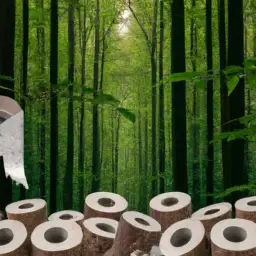
Before we can fully appreciate the benefits of eco-friendly toilet paper, it is essential to understand the environmental impact of traditional toilet paper. The production and use of traditional toilet paper can have detrimental effects on the environment. Let’s take a closer look at some of the key aspects to assess its sustainability.
One of the main environmental concerns with traditional toilet paper is deforestation. To produce toilet paper, millions of trees are cut down each year, leading to habitat destruction and loss of biodiversity. Additionally, the manufacturing process involves large amounts of water and energy consumption, contributing to greenhouse gas emissions and water pollution.
To further understand the environmental impact of traditional toilet paper, let’s compare it with some alternatives. In the table below, we can see a comparison between traditional toilet paper, recycled toilet paper, and bamboo toilet paper.
| Aspect | Traditional Toilet Paper | Recycled Toilet Paper | Bamboo Toilet Paper |
|---|---|---|---|
| Deforestation | High | Low | Very Low |
| Water Usage | High | Moderate | Low |
| Energy Usage | High | Moderate | Low |
| Biodiversity | Negative impact | Neutral | Positive impact |
The Benefits of Bamboo Toilet Paper

When considering eco-friendly toilet paper options, one can’t overlook the benefits of bamboo toilet paper. Bamboo toilet paper offers a sustainable alternative to traditional toilet paper, making it an excellent choice for environmentally conscious individuals.
One of the primary benefits of bamboo toilet paper is its sustainability. Bamboo is a fast-growing plant that can be harvested and regrown within three to five years, whereas traditional toilet paper is made from trees that take decades to grow. By using bamboo toilet paper, we can help conserve forests and reduce deforestation.
Additionally, bamboo toilet paper is biodegradable and compostable. It breaks down easily in water and decomposes quickly in landfills, unlike traditional toilet paper, which can take years to degrade. This means that by choosing bamboo toilet paper, we can reduce our environmental impact and contribute to a healthier planet.
Furthermore, bamboo toilet paper is softer and stronger than traditional toilet paper. It provides a luxurious and comfortable experience while still being durable and reliable. This makes it a practical choice for households of all sizes.
How to Identify Truly Biodegradable Toilet Paper
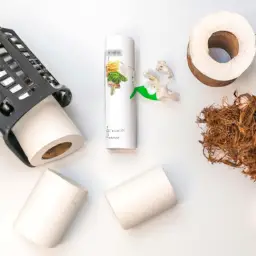
To determine if a toilet paper is truly biodegradable, look for certifications from recognized organizations such as the Forest Stewardship Council (FSC) or the Biodegradable Products Institute (BPI). These eco-friendly certifications ensure that the toilet paper meets certain environmental standards and is made from sustainable materials. However, it is important to note that not all biodegradable toilet papers are created equal. Some may claim to be biodegradable, but without proper certifications, it is difficult to verify their claims.
When shopping for truly biodegradable toilet paper, it is helpful to consider alternative options such as bamboo or recycled paper. These materials are more sustainable and have a lower impact on the environment compared to traditional toilet paper made from virgin wood pulp. Additionally, look for toilet paper that is chlorine-free and made without harmful chemicals. This will further reduce the environmental impact and make the toilet paper safer for both you and the planet.
To make it easier for you to identify truly biodegradable toilet paper, here is a handy table outlining some eco-friendly certifications to look for:
| Certification | Description |
|---|---|
| FSC | Ensures that the toilet paper is made from responsibly sourced wood fibers. |
| BPI | Certifies that the toilet paper meets strict biodegradability and compostability standards. |
Comparing Different Eco-Friendly Toilet Paper Options
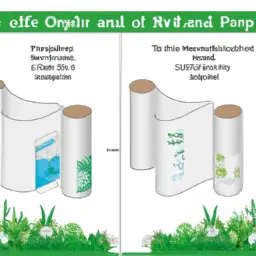
As I compare different eco-friendly toilet paper options, I consider factors such as material source, sustainability certifications, and environmental impact.
When comparing features, it’s important to look at the type of material used in the toilet paper. Some eco-friendly options are made from recycled paper, while others use bamboo or sugarcane fibers. Recycled paper is a good choice as it helps reduce the demand for virgin trees. Bamboo and sugarcane are also sustainable options as they’re fast-growing and require less water and pesticides compared to traditional trees.
Another important factor to consider is sustainability certifications. Look for toilet paper that has been certified by reputable organizations such as the Forest Stewardship Council (FSC) or the Programme for the Endorsement of Forest Certification (PEFC). These certifications ensure that the toilet paper comes from responsibly managed forests or sustainable sources.
Lastly, consider the environmental impact of the toilet paper. Some eco-friendly options are chlorine-free, meaning they don’t use bleach during the manufacturing process. This helps prevent the release of harmful chemicals into the environment. Additionally, look for toilet paper that’s packaged in recyclable or compostable materials to further reduce waste.
Finding the Right Bamboo Toilet Paper Brand for You
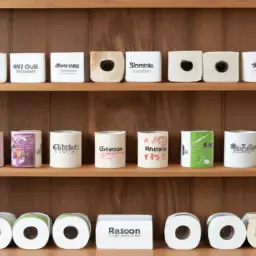
I prefer using bamboo toilet paper brands that are soft, sustainable, and environmentally friendly. When it comes to choosing the right bamboo toilet paper brand, there are a few factors to consider.
First, it’s important to compare bamboo toilet paper with recycled toilet paper to understand the differences. While both options are eco-friendly alternatives to conventional toilet paper, bamboo toilet paper has some unique advantages. Bamboo is a fast-growing grass that regenerates quickly, making it a highly sustainable resource. It also requires fewer resources, such as water and energy, to produce compared to recycled paper.
Additionally, bamboo toilet paper is naturally soft and strong, providing a pleasant experience while also being gentle on the skin.
In terms of finding the right brand, it’s essential to look for certifications like Forest Stewardship Council (FSC) or Rainforest Alliance to ensure the product meets recognized sustainability standards. It’s also worth considering factors like packaging, such as opting for brands that use minimal or biodegradable packaging.
Tips for Properly Disposing of Biodegradable Toilet Paper
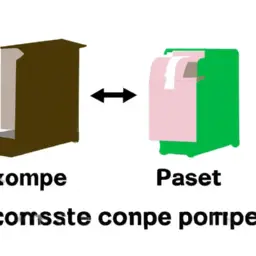
One important tip is to always flush biodegradable toilet paper in small amounts and never in large quantities, as it can lead to clogging.
Proper disposal methods for biodegradable toilet paper go beyond flushing. If you want to minimize waste and support a more sustainable lifestyle, consider composting options.
Composting is a great way to dispose of biodegradable toilet paper. To do this, you’ll need a compost bin or pile in your yard. Make sure to shred the toilet paper before adding it to the compost to accelerate the decomposition process. Mix it with other organic materials such as food scraps, yard waste, and leaves. Turn the compost regularly to help it break down faster. Within a few months, the compost will transform into nutrient-rich soil that can be used in your garden.
If you don’t have the space or resources for composting, you can also check if your local waste management facility accepts biodegradable toilet paper. Some facilities have special composting programs or systems that can handle this type of waste. Reach out to your local authorities or waste management companies to inquire about the options available in your area.
Making the Switch: Steps to Transition to Eco-Friendly Toilet Paper

To successfully transition to eco-friendly toilet paper, I recommend following three simple steps.
First, educate yourself about the different eco-friendly alternatives available on the market. There are various options to choose from, including bamboo, recycled paper, and hemp toilet paper. Each has its own unique benefits and considerations, so it’s important to research and find the one that aligns with your values and preferences.
Next, start by making small changes. You don’t have to switch all at once. Begin by incorporating eco-friendly toilet paper into your routine gradually. For example, you can start by using eco-friendly toilet paper for a few days a week and gradually increase it over time.
Lastly, make sure to dispose of the eco-friendly toilet paper properly. Many eco-friendly alternatives are biodegradable, but it’s still important to follow the proper guidelines for disposal. Check the packaging or manufacturer’s instructions for specific guidance. By doing so, you can ensure that you’re not only using eco-friendly toilet paper but also properly managing its waste.
Conclusion
I hope this step-by-step guide has helped you understand the importance of choosing eco-friendly toilet paper and how to make the switch.
By opting for bamboo toilet paper and properly disposing of it, you can reduce your environmental impact and contribute to a more sustainable future.
Remember, small changes in our everyday choices can make a big difference in preserving the planet for future generations.

